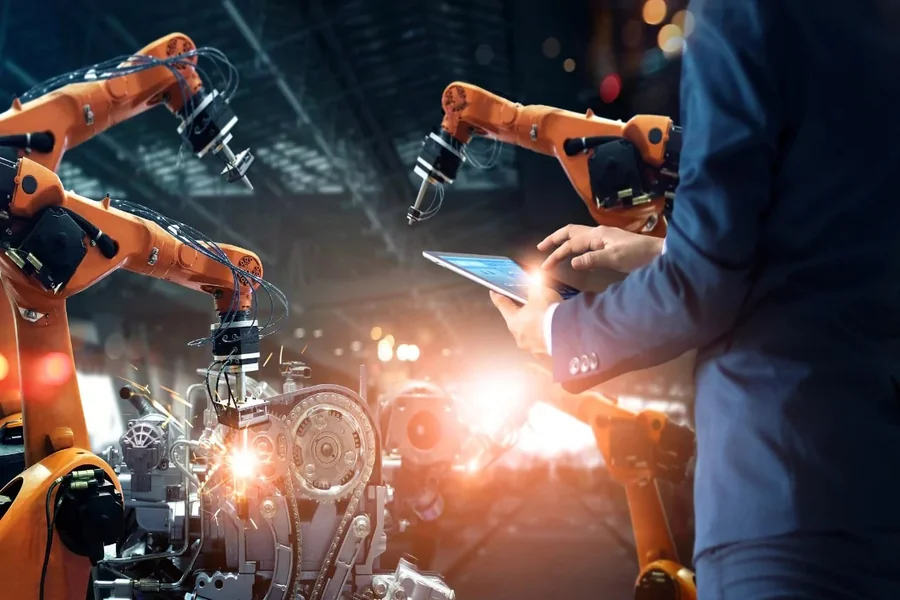Automation is changing modern manufacturing, and robotic welding arms are at the forefront. A robotic welding arm is a programmable machine with a moving arm, sensors, and welding tools that can join metal parts accurately and reliably. It can work non-stop without getting tired, following exact weld paths to ensure high-quality results.
Understanding robotic welding arms is essential for businesses today because they improve productivity, ensure consistent product quality, reduce material waste, and help companies stay competitive in a rapidly evolving industrial landscape.
What Is a Robotic Welding Arm?
A robotic welding arm is an automated machine designed to perform welding with high accuracy and efficiency. It combines advanced sensors, programmable controls, and welding tools to processes like MIG, TIG, and laser welding. These systems are ideal for manufacturing environments that require consistent quality and high-volume production.
Core Components of a Robotic Welding Arm
- Arm: The structure with joints and links that allows precise movement and reach.
- Controller: The central unit that interprets programming and coordinates the arm’s movements.
- Sensors: Monitor variables like temperature, position, and weld quality, enabling real-time adjustments.
- End Effector (Welding Torch): The tool at the arm’s end that performs the weld, which varies depending on the process.
These components work together to perform accurate, repeatable welds, improving productivity, quality, and safety in manufacturing.
How a Robotic Welding Arm Works
1. Programming the Robot
The first step is programming. Engineers use specialized software or a teach pendant to give the robot instructions. These instructions define:
- The path the robot should take: the exact route the arm needs to move along.
- The speed of movement: how fast the robot should move while welding.
- The welding method: the type of welding to use, like MIG, TIG, or spot welding.
- The timing of each weld: when to start and stop each weld.
This programming ensures that every weld is accurate, repeatable, and consistent, even across thousands of parts. Robots can also be reprogrammed when new designs or tasks are required, giving manufacturers flexibility.
2. Placing the Workpiece
The workpiece is positioned in the robot’s workspace, either manually or automatically, to ensure the weld follows the programmed path accurately.
- Manually: A worker carefully places and secures the metal part in the correct position.
- Automatically: Machines such as conveyors, jigs, or another robot position the metal part precisely without human intervention.
Some setups include sensors or fixtures that help confirm correct placement before welding begins, reducing errors.
3. Performing the Weld
Once everything is ready, the robotic arm moves its welding torch along the programmed path. Depending on the welding type:
- In arc welding, electricity generates intense heat that melts the edges of the metal pieces.
- Molten filler material may also be added to strengthen the joint.
- As the metal cools, it fuses into a strong, clean, and durable weld.
Robotic welders can repeat this process continuously, maintaining a level of precision and speed that is difficult for manual welders to achieve.
- Post-Weld Tasks
- After welding is finished, the robotic welding arm can perform additional tasks to ensure quality and efficiency:
- Removing Spatter – The robot cleans off small metal splashes that form during welding.
- Inspecting the Weld – Built-in cameras or sensors check the weld for any defects or issues.
- Preparing for the Next Workpiece – The robot returns to its starting position or signals another machine to place the next metal part.
These tasks help keep production smooth, maintain consistent weld quality, and reduce downtime. A robotic welding arm follows exact instructions, with the metal piece properly positioned. It welds accurately, and after finishing, checks and cleans to ensure each product is strong, safe, and high quality.
Benefits of Using a Robotic Welding Arm
Robotic welding arms offer transformative advantages for manufacturers looking to improve efficiency, quality, and safety. Here’s a clear overview of the key benefits:
- Enhanced Weld Quality and Consistency
Robotic arms deliver precise, repeatable welds, reducing human error and ensuring uniform quality across production runs. This consistency is important for industries with strict quality standards.
- Increased Productivity and Throughput
Robotic welders can work nonstop, producing more parts faster than humans. This helps factories meet deadlines and get more work done efficiently.
- Reduced Material Waste
Robots use exact amounts of filler material, minimizing scrap and reducing costs. This precision also supports sustainability by lowering material consumption.
- Lower Labor Costs
Automating repetitive and physically demanding tasks reduces the need for manual labor, cutting costs and allowing workers to focus on more complex or value-added activities.
- Improved Workplace Safety
Robotic welders do the dangerous work, like handling hot metal, sparks, or harmful fumes. This keeps human workers safer and helps prevent injuries in the workplace.
- Adaptability to Complex Shapes
Robotic welders can handle metal parts with tricky or unusual shapes. They follow detailed weld paths accurately, making them useful for many products and industries. This flexibility lets manufacturers create custom or detailed parts without losing quality or speed.
- Scalability for High-Volume Production
Robotic welding systems can easily handle more work as production needs grow. Factories can add more robots, run them longer, or reprogram them for new tasks. This helps produce more products quickly while keeping each weld accurate and of high quality, making it easier to meet deadlines and growing demand.
Robotic welding arms help make work better, faster, and safer, and their long-term benefits are worth the upfront cost.
Applications of Robotic Welding Arms
Robotic welding arms are used across industries to improve speed, accuracy, and safety in manufacturing. Here’s how various sectors benefit from them:
- Automotive Manufacturing
Robots weld car bodies and frames using spot and arc welding. They work quickly and accurately, maintaining consistent quality while producing large numbers of vehicles.
- Aerospace and Defense
Robots help assemble airplane parts. Their precision ensures strong, reliable joints that meet strict quality standards.
- Shipbuilding and Heavy Machinery
In shipbuilding, robots weld large metal structures and thick materials, boosting productivity and consistency. Heavy machinery production also benefits from precise, strong welds.
- Electronics and Consumer Goods
Robots weld metal parts in electronics such as computer cases, smartphones, and tablets. This ensures high-quality welds and faster production to meet demand.
- Construction and Metal Fabrication
Robots weld steel structures, bridges, and buildings, creating durable and safe joints. They also make custom metal parts efficiently for various applications.
Robotic welding arms are versatile and efficient tools that enhance quality, safety, and speed across a wide range of industries.
Conclusion
Robotic welding arms are revolutionizing modern manufacturing by combining precision, efficiency, and safety. They follow programmed instructions to perform accurate, repeatable welds, reduce material waste, handle complex shapes, and operate continuously without fatigue. These capabilities lead to higher productivity, lower labor costs, and consistent product quality.
Widely used across industries such as automotive, aerospace, shipbuilding, electronics, and construction. Despite the high upfront cost, robotic welding arms provide faster production, safer workplaces, and better quality, making them essential for modern manufacturing.





